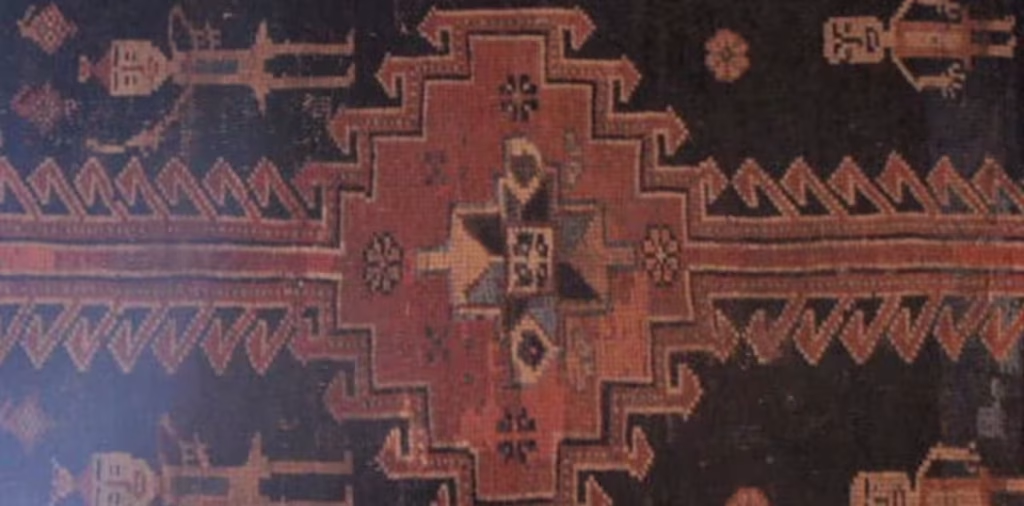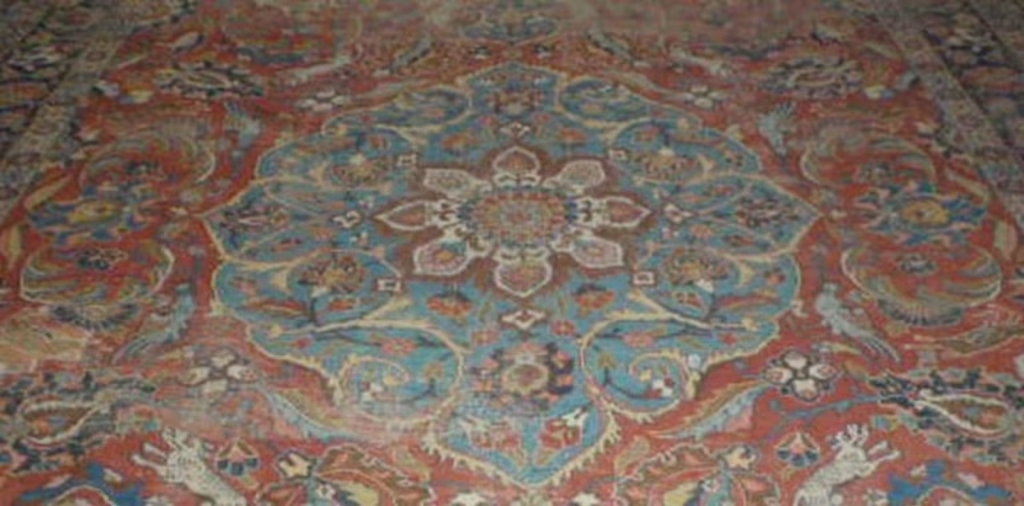Design
The enormous variety displayed by the designs of oriental carpets is a fascinating and stimulating study in itself. Different types of patterns and designs have been developed in different districts. Geometrical designs are often found together with other motifs but in some places they have been refined and may characterize the place of manufacture. The most common designs are those base on flowers but these have been revised and stylized into a number of different types. Religion is of decisive importance in the use of the human form in art. The Koran does not permit the portrayal of living beings. Both people and animals are portrayed nevertheless in Persia, where religious attitudes are more liberal, and in the Caucasus. This is also the case in China, where the designs are markedly different from those of Central Asia.
When considering the designs on different carpets one should bear in mind both the function of the carpet and the environment in which it was produced. A number of terms for carpets indicate their use, e.g., Enessi which indicates a door drapery, Hehbelyk which is a sadle cover and Namaslyk which is the prayer-rug of the Moslem. These terms also give some indication of the size. This is even more true of names like Ghali, which means carpet and stands for the large rectangular type usually found in the centre of a Persian room. Around this lie the Kenareher, runners, often comprising a series with the same design. There are several other similar terms, all of them with definite types of design suitable to their function and size (se pages 213-214).
So far as the conditions under which they are produced are concerned, a distinction must be made between carpets for domestic needs and those done to order on a more magnificent scale. The carpets produced by nomadic tribes differ from those made by the settled population in that they are woven more intuitively without recourse to any pattern or drawing. They are generally relatively small, with geometrical and stylized designs. Settled weavers usually work from a predesigned pattern or cartoon and are thus able to produce carpets with richer, more varied designs. The cartoon is known as a Talim and consists of squared paper on which the pattern is reproduced. Each square stands for a knot in that particular colour. Mostly, the weavers work independently with this sketch in front of them. In the past, however, a foreman dictated the colours, particularly if two identical carpets were to be made. He then placed himself between a pair of looms and dictated the work for both carpets.
design depends upon the type of carpet
The composition of the design thus depends upon the type of carpet and follows carefully defined rules. On the basis of the pattern of the field, one can distinguish between four different types.
- Medallion design.
- All-over or repeat design.
- Design with figures or representational design.
- Niche and tree design.
The first group comprise the patterns in which the field, in a single colour or with small designs, is dominated by a central medallion. The second group, with its dense repeating patern cut off by the borders, has a more ancient appearance and is often based on more geometrical shapes. The third group comprises the naturalistic reproductions of people and animals. The last group, the niche and tree design, is uniform from the point of view of function, even though the pattern varies considerably.
These typical field designs are nearly always surrounded by a main border and narrower secondary borders or guards. Exceptions to this rule are, for instance, certain prayer rugs with the niche design and recent Saruk and Kerman carpets, which often have a broken floral border, and the Chinese carpets, which include a number of special types outside this classification
The numerous details found in oriental carpets include a number that are very common. One of these is the Mir-Ibotha design, an oval figure filled with rosettes and flowers. This may be interpreted in several ways: as a winding river, as the imprint of a clenched, bloody hand, or as a flame. Another classical design, common as the main pattern, is the Shah Abbas design. This consists of large floral designs, cloud bands, arabesques, vases and palmettos. Guli Henna is a pattern showing a stylized Henna plant. The Mina-Khanipatern, a floral design surrounded by four similar smaller flowers, is also used as a main design.
In the borders one finds patterns that are more familiar to the western world. A couple of examples of simple geometrical designs and ornaments are the meander and the device called “the running dog”. The Greek cross is also found, but more common is the swastika, a symbol of happiness.
Another type of pattern sometimes found on carpets consists of inscriptions and dates with Arabic writing. The decorative inscriptions comprise aphorisms by some well-known author, such as Sadi, Hafez or Firdausi, but they may also be verses from the Koran. They are generally surrounded by a cartouche.
Dates in Arabic numerals refer, of course, to the Mohammedan calendar. This starts with Mohammed’s journey from Mecca on the 16th July, 622 A.D. the Mhammedan year is shorter than ours by approximately 1/33. To arrive at a carpet’s age on the basis of an Arabic date, e.g., 132 proceed as follows:
Divide the date by 33 (1322 ÷ 33 =40).
Subtract the quotient from the year (1322 – 40=1282).
Add 622 (1282 + 622=1904).
Thus a carpet of 1322 by the Arabic calendar should be dated 1904 according to our calendar.
However one cannot always rely on a carpet’s date being genuine. It has happened that the figures have been a altered to a more advantageous date.
In the past each district used its traditional patterns and designs, which served as a means of telling where a particular carpet had been made. This is no longer the case; Tabriz patterns are now made in Kerman, and, vice versa, Seraband patterns in Turkey, Kerman patterns in Arak, etc.
There are many details that should be checked when buying a carpet. Some of them can be seen to at once, others must wait until the carpet has been taken home for a final look. Unfortunately, most buyers attach the greatest importance to exact colours and measurements. However, greater attention should be paid to quality, condition and pattern. A good carpet will in fact last a lifetime and should consequently be bought to be enjoyed as a work of art. Once again, let me repeat: rely only on reputable firms with long experience. You can then have confidence in your purchase. Buying at auctions and the like, with no chance of thoroughly checking the piece, can only be described as happy-go-lucky.
First check:
That the carpet lies flat on the floor; bulges or folds will lead to greater wear in those places and detract from the appearance of the carpet; that the carpet is not too crooked; minor deviations should be accepted since this is a handicraft, particularly in the case of nomad carpets.
That the Kelim edges at the ends and the over sewing or braiding along the sides is not damaged, since these are intended to protect the knotted part of the carpet. Minor damage can easily be made good by a specialist without detracting from the carpet’s value;
That the pattern is in harmony with the carpet’s size in that there is no uncalled-for mutilation of the pattern at the border and that each corner that the harmony is maintained there as well. After that, check the pile of the carpet. The surface should not be too uneven as a result of poor trimming or other factors.
Check the colours too. Make sure that the colours have not run into the light parts that the surface of the pile has neither faded nor become excessively discoloured when compared with the colour inside. Nowadays there is not much risk of meeting aniline dyed carpets, apart from some Turkish pieces and some older Indian carpets. Minor differences in colour between the surface and the foot of the pile may be tolerated.
By moistening the surface of the pile one can check a couple of pints. If a lot of colour comes off when the surface is rubbed with a piece of white linen, the colour is of inferior quality. Then one can smell the damp part of the carpet. A strong whiff of chlorine means that the carpet has been dry-cleaned and was probably rinsed badly after the treatment. This may mean a loss of durability. Excessively bleached carpets, so-called gold-Bokhara or gold-Afghan, may have a shorter lifetime after such treatment.
The next step is to inspect the underside of the carpet. First the evenness of the knots, then whether the carpet has been repaired. This is easiest to see on the back. A minor repair probably done is no great disadvantage, but large repairs can affect the carpet’s value.
Damage from moths on the underside will lay bare the wrap in those places. As a result, the pile may work loose if the knot’s anchorage has been eaten up by the moth.
The warp and the weft may b damaged as well but unfortunately this cannot always be seen.
Such damage may be due to one of two causes; either the yarn is too weak in relation to the carpet’s weight or the carpet nay have become damp and not been allowed to dry in a suitable manner.
To discover whether the weft is too weak or damaged, a rather extreme test can be made: fold back the carpet along a row of knots, then take hold of the folded carpet with both hands quite close to each other and pull both hands apart and downwards so as to bear on the weft threads. A cracking sound means that the weft have broken, leaving a longitudinal split. Such a test must be made with the utmost care, preferably by a specialist.
Sometimes a carpet that is specially washed receives such hard treatment that certain colours, usually in plain fields, have to be touched up. This can be seen because the colour will not be evenly distributed over the pile and there will be a large difference in colour between the pile and the back of the carpet.
Some carpets display belts of various widths in different shades, so called “abrashes”. There are several reasons for this. Several different batches of yarn may have been used, with some of them dyed a slightly different shade. Wool from different sheep may also take differently even though it is all dipped in the same dye bath. A large number of wide abrashes in one carpet id not particularly attractive but a few simply give the carpet a more lively appearance and consequently can be tolerated. However, these abrashes can hardly be controlled by the carpet-maker and will therefore be found even in the best qualities.


